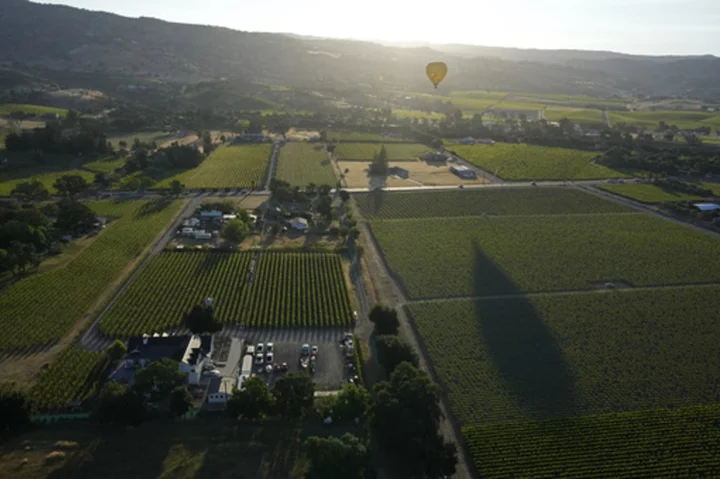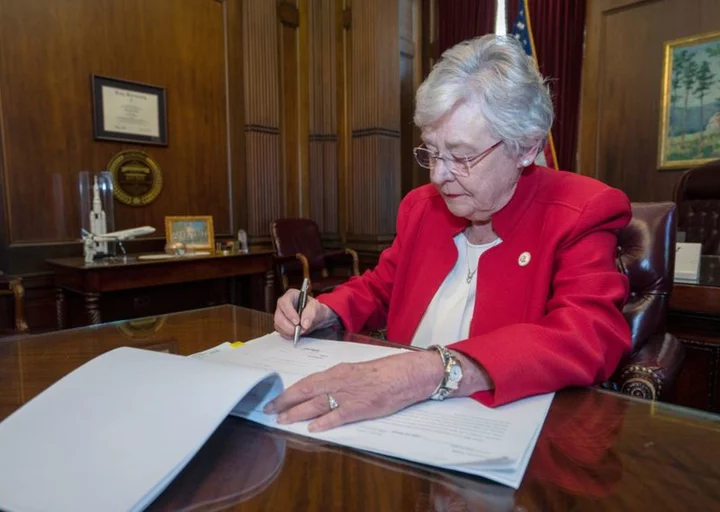NAPA, Calif. (AP) — As sunlight spilled into California's famed Napa Valley on a summer day, rows of wine grapes reflected the benefits of this winter's record rainfall.
California has more than 960 square miles (2,488 square kilometers) of vineyards dedicated to the wine industry, perhaps none as iconic as those growing in Napa Valley just north of San Francisco.
This year, wine grapes are thriving after record winter rainfall in California, but cool days of spring that have carried into summer are threatening to keep the grapes from ripening. The longer the fruit has to stay on the vine the more exposed it is to possible wildfires in the fall and rain in early winter.
The state’s normally bountiful wine grape harvest had been hindered in recent years by a combination of drought and wildfires.
California growers reported $600 million worth of grapes lost to smoke damage after the 2020 fire season, the office of U.S. Sen. Alex Padilla said. California's wine industry generates $170.5 billion annually, according to the California Association of Winegrape Growers.
Now, a trip high above the valley in a hot air balloon revealed miles of lush, green vineyards.
Elias Fernandez, who has been the winemaker at Shafer Vineyards for 40 years, said the vines have 10% to 15% more fruit than last year. But he said cooler temperatures this summer could delay the harvest.
“The vines are just really happy and growing,” Fernandez said. “The nice thing is that they’re not completely full, so they are spread out, which is really ideal for ripening the whole berries.”
But whether they ripen before harvest, which usually starts after Labor Day, will depend on getting some warm, sunny days in the next couple of weeks, he said.
“The last time I checked, we were behind a couple of weeks and whenever we start to run behind, you start thinking about how (the harvest) can get closer to the rainy season,” he said.
Fernandez said it’s a bit early to know if there is trouble ahead for the harvest.
“This could turn around and we could start seeing 95 to 100 degrees (35 to 37 degrees Celsius). It’s a wait-and-see kind of situation,” he said.
“But right now it looks pretty set up to be a nice vintage, we really just need a little more sun,” he added.
In recent years, Northern California’s wine country has been hit by major wildfires, driven by a changing climate, that destroyed parts of the world-famous region and left little doubt it is vulnerable to smoke and flames.
Shafer Vineyards lost its entire crop in 2020 after smoke from a devastating wildfire season tainted the grapes, Fernandez said.
Padilla and U.S. Rep. Mike Thompson, who both represent Napa Valley, introduced legislation in Congress this week to protect wine grape growers against wildfire smoke damage in the top wine-producing states in the country: California, Washington and Oregon. If approved, the two bills would strengthen research into “smoke taint” and order federal regulators to develop “fair insurance products for growers,” Padilla’s office said in a statement.
___
Rodriguez reported from San Francisco.
___
Associated Press climate and environmental coverage receives support from several private foundations. See more about AP’s climate initiative here. The AP is solely responsible for all content.









